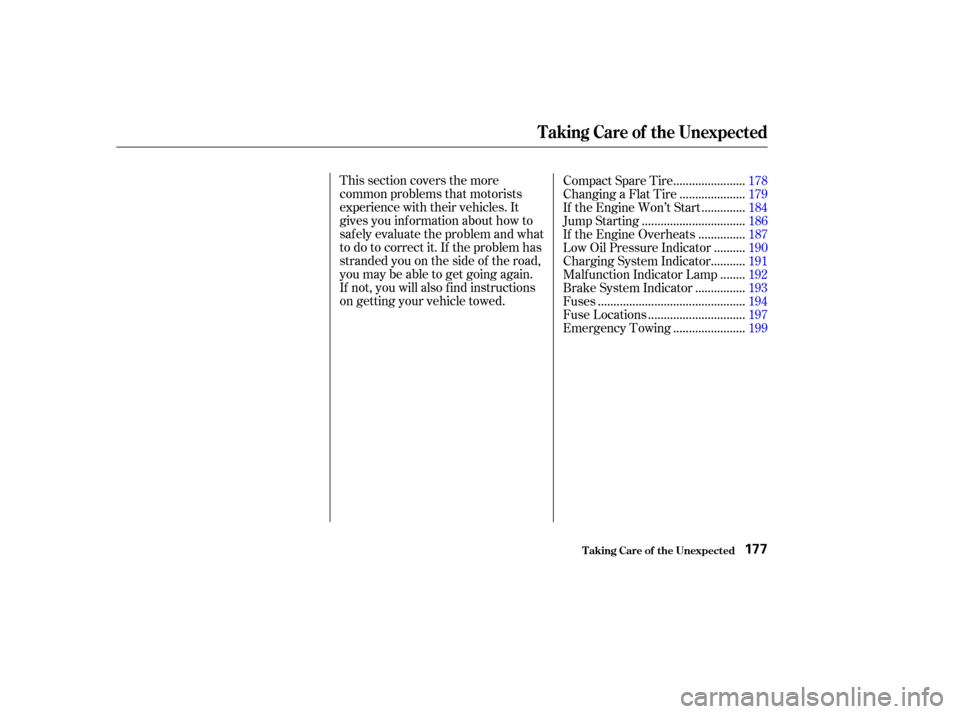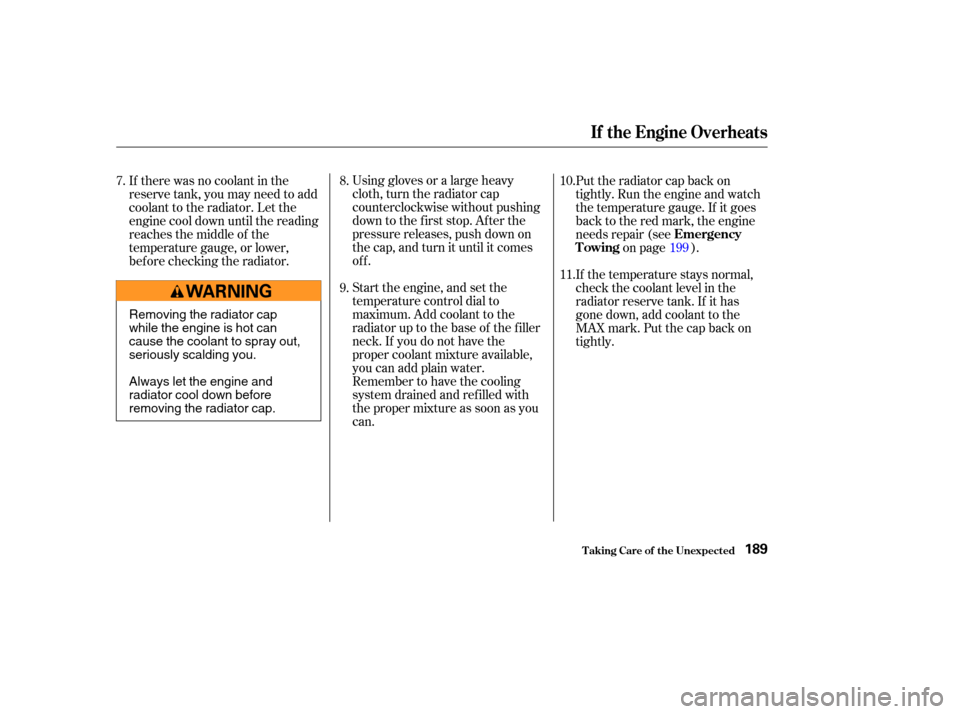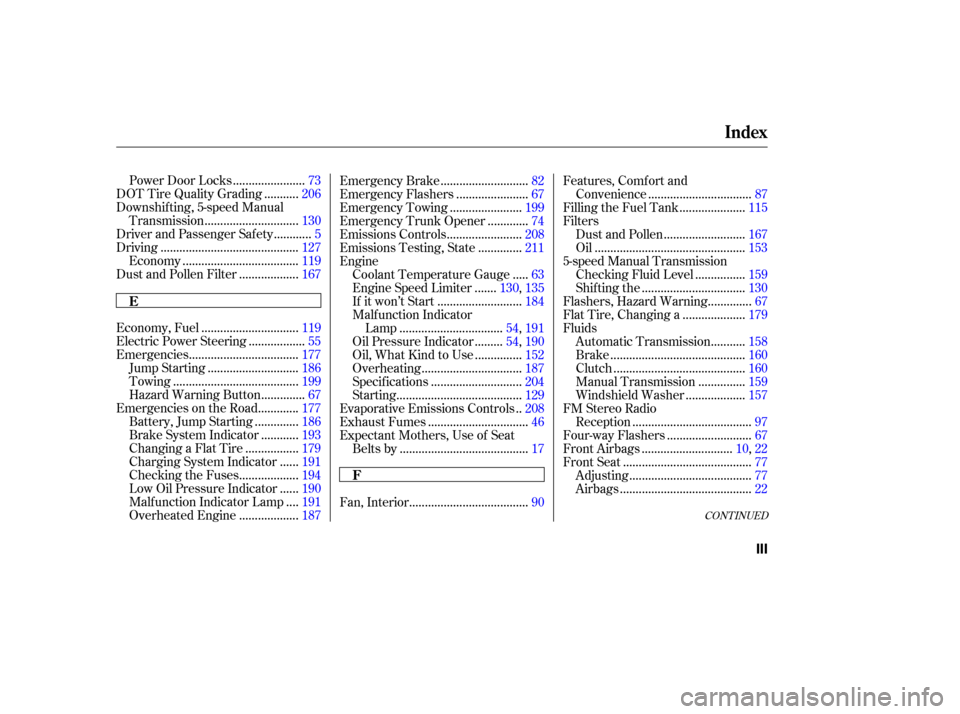2004 HONDA CIVIC HYBRID engine overheat
[x] Cancel search: engine overheatPage 58 of 231

This indicator normally comes on
when you turn the ignition to ON (II)
and goes off after the engine starts.
If it comes on at any other time,
there is a problem in the Electric
Power Steering system. If this
happens, stop the vehicle in a saf e
place and turn of f the engine. Reset
the system by restarting the engine.
The indicator will not turn of f
immediately. If it does not go of f
after driving a short distance, or
comes back on again while driving,
take the vehicle to your dealer to
have it checked. With the indicator
on, the EPS may be turned of f ,
making the vehicle harder to steer.This indicator normally comes on f or
a f ew seconds when you turn the
ignition switch to ON (II). If it comes
on at any other time, it indicates a
problem in the Integrated Motor
Assist (IMA) system. With the IMA
indicator on, the vehicle may not
accelerate as it normally does. Have
the vehicle checked by the dealer as
soon as possible.
See pages and .
If you drive with the system
overheated continuously or
repeatedly, this can damage the
power steering system.
If the power steering system
overheats while driving, the assisting
power is reduced and steering may
f eel slightly harder. This indicator comes on f or a f ew
seconds when you turn the ignition
switch to ON (II). It will then go of f
if you have inserted a properly-coded
ignition key. If it is not a properly-
coded key, the indicator will blink
and the engine will not start (see
page ).
This indicator also blinks several
times when you turn the ignition
switch f rom ON (II) to ACCESSORY
(I) or LOCK (0).
71
132 137
Inst rument s and Cont rols
Electric Power Steering
(EPS) Indicator IMA System Indicator
A uto Idle Stop Indicator
Immobilizer System
Indicator
Instrument Panel
55
Page 133 of 231

The manual transmission is syn-
chronizedinallforwardgearsfor
smooth operation. It has a lockout so
you cannot shift directly from Fifth
to Reverse. When shif ting up or
down,makesureyoupushtheclutch
pedal down all the way, shift to the
next gear, and let the pedal up
gradually. When you are not shif ting,
do not rest your f oot on the clutch
pedal. This can cause your clutch to
wear out faster.Come to a full stop before you shift
into Reverse. You can damage the
transmission by trying to shif t into
Reverse with the vehicle moving.
Push down the clutch pedal, and
pause f or a f ew seconds bef ore
shif ting into Reverse, or shif t into
one of the f orward gears f or a
moment. This stops the gears so
they won’t ‘‘grind.’’
When slowing down, you can get
extra braking f rom the engine by
shifting to a lower gear. This extra
braking can help you maintain a safe
speed and prevent your brakes f rom
overheating while going down a
steep hill. Bef ore downshif ting,
make sure the vehicle speed is low
enough that you will not activate the
engine speed limiter in the lower
gear. Make sure the engine speed
will not go into the tachometer’s red
zone in the lower gear bef ore
downshif ting.
If you exceed the maximum speed
f or the gear you are in, the engine
speed will enter into the tachometer’s
red zone. If this occurs, you may f eel
the engine cut in and out. This is
caused by a limiter in the engine’s
computer controls. The engine will
run normally when you reduce the
RPM below the red zone.
Bef ore downshif ting, make sure the
engine will not go into the
tachometer’s red zone.
5-speed Manual T ransmission
Driving
Engine Speed L imiter
130
Rapid slowing or speeding-up
can cause loss of control on
slippery surfaces. If you crash,
you can be injured.
Use extra care when driving on
slippery surfaces.
Page 180 of 231

This section covers the more
common problems that motorists
experience with their vehicles. It
gives you inf ormation about how to
safely evaluate the problem and what
to do to correct it. If the problem has
stranded you on the side of the road,
you may be able to get going again.
If not, you will also f ind instructions
on getting your vehicle towed.......................
Compact Spare Tire .178
....................
Changing a Flat Tire .179
.............
If the Engine Won’t Start . 184
................................
Jump Starting .186
..............
If the Engine Overheats . 187
.........
Low Oil Pressure Indicator . 190
..........
Charging System Indicator . 191
.......
Malf unction Indicator Lamp . 192
...............
Brake System Indicator . 193
..............................................
Fuses .194
..............................
Fuse Locations .197
......................
Emergency Towing .199
Taking Care of the Unexpected
T aking Care of t he Unexpect ed177
Page 190 of 231

Start your vehicle. If the starter
motor still operates slowly, check
that the jumper cables have good
metal-to-metal contact.
Once your vehicle is running,
disconnect the negative cable f rom
your vehicle, then f rom the
booster battery. Disconnect the
positive cable f rom your vehicle,
and then from the booster battery.
Keep the ends of the jumper cables
away from each other and any metal
on the vehicle until everything is
disconnected. Otherwise, you may
cause an electrical short.
If your vehicle’s 12 volt battery is
disconnected or goes dead, the IMA
battery level gauge reading may not
be correct the next time you turn the
ignition switch to ON (II). It may
show less than the actual level
temporarily. It will show the correct
level af ter you drive f or at least 30 minutes.
The reading on your vehicle’s
temperature gauge should stay in
the midrange. If it climbs to the red
mark, you should determine the
reason (hot day, driving up a steep
hill, etc.).
If your vehicle overheats, you should
take immediate action. The only
indication may be the temperature
gauge climbing to or above the red
mark. Or you may see steam or
spray coming f rom under the hood.
7. 6.
CONT INUED
T aking Care of t he Unexpect ed
Jump Starting, If the Engine Overheats
If the Engine Overheats
187
NOTICE: Steam and spray from an
overheated engine can
seriously scald you.
Do not open the hood if steam
is coming out.
Driving with the
temperature gauge pointer at the red
mark can cause serious damage to
your engine.
Page 191 of 231

Saf ely pull to the side of the road.
Put the transmission in Neutral or
Park, and set the parking brake.
Turn of f all the accessories, and
turn on the hazard indicator.
If you see steam and/or spray
coming f rom under the hood, turn
of f the engine. Wait until you see
no more signs of steam or spray,
then open the hood.If you do not see steam or spray,
leave the engine running and
watch the temperature gauge. If
the high heat is due to overloading,
the engine should start to cool
down almost immediately. If it
does, wait until the temperature
gauge comes down to the midpoint,
then continue driving.
If the temperature gauge stays at
the red mark, turn of f the engine.Look f or any obvious coolant leaks,
such as a split radiator hose.
Everything is still extremely hot,
so use caution. If you f ind a leak, it
must be repaired bef ore you
continue driving (see
on page ).
If you don’t f ind an obvious leak,
check the coolant level in the
radiator reserve tank. Add coolant
if the level is below the MIN mark.
1.
2.
3.
4.5.
6.
199
If theEngineOverheats
T aking Care of t he Unexpect ed
Emergency
Towing
188
Page 192 of 231

Using gloves or a large heavy
cloth, turn the radiator cap
counterclockwise without pushing
down to the first stop. After the
pressure releases, push down on
the cap, and turn it until it comes
off.
Start the engine, and set the
temperature control dial to
maximum. Add coolant to the
radiator up to the base of the f iller
neck. If you do not have the
proper coolant mixture available,
you can add plain water.
Remember to have the cooling
system drained and ref illed with
the proper mixture as soon as you
can.Put the radiator cap back on
tightly. Run the engine and watch
the temperature gauge. If it goes
back to the red mark, the engine
needs repair (see
on page ).
If the temperature stays normal,
check the coolant level in the
radiator reserve tank. If it has
gone down, add coolant to the
MAX mark. Put the cap back on
tightly.
If there was no coolant in the
reserve tank, you may need to add
coolant to the radiator. Let the
engine cool down until the reading
reaches the middle of the
temperature gauge, or lower,
bef ore checking the radiator.
8.
9. 10.
11.
7.
199
If theEngineOverheats
T aking Care of t he Unexpect ed
Emergency
Towing
189
Removing the radiator cap
while the engine is hot can
cause the coolant to spray out,
seriously scalding you.
Always let the engine and
radiator cool down before
removing the radiator cap.
Page 224 of 231

CONT INUED
......................
Power Door Locks .73
..........
DOT Tire Quality Grading . 206
Downshif ting, 5-speed Manual
.............................
Transmission .130
...........
Driver and Passenger Safety . 5
...........................................
Driving .127
....................................
Economy .119
..................
Dust and Pollen Filter . 167
..............................
Economy, Fuel .119
.................
Electric Power Steering . 55
..................................
Emergencies .177
............................
Jump Starting .186
.......................................
Towing .199
.............
Hazard Warning Button . 67
............
Emergencies on the Road . 177
.............
Battery, Jump Starting . 186
...........
Brake System Indicator . 193
................
Changing a Flat Tire . 179
.....
Charging System Indicator . 191
..................
Checking the Fuses . 194
.....
Low Oil Pressure Indicator . 190
...
Malf unction Indicator Lamp . 191
..................
Overheated Engine . 187...........................
Emergency Brake .82
......................
Emergency Flashers .67
......................
Emergency Towing .199
............
Emergency Trunk Opener . 74
.......................
Emissions Controls .208
.............
Emissions Testing, State . 211
Engine ....
Coolant Temperature Gauge . 63
......
Engine Speed Limiter . 130,135
..........................
If it won’t Start .184
Malf unction Indicator ................................
Lamp .54, 191
........
Oil Pressure Indicator . 54,190
..............
Oil, What Kind to Use . 152
...............................
Overheating .187
............................
Specif ications .204
.......................................
Starting .129
.
Evaporative Emissions Controls . 208
...............................
Exhaust Fumes .46
Expectant Mothers, Use of Seat ........................................
Belts by .17
.....................................
Fan, Interior .90 Features, Comfort and
................................
Convenience .87
....................
Filling the Fuel Tank . 115
Filters .........................
Dust and Pollen .167
...............................................
Oil .153
5-speed Manual Transmission ...............
Checking Fluid Level . 159
................................
Shif ting the .130
.............
Flashers, Hazard Warning . 67
...................
Flat Tire, Changing a . 179
Fluids ..........
Automatic Transmission . 158
..........................................
Brake .160
.........................................
Clutch .160
..............
Manual Transmission . 159
..................
Windshield Washer . 157
FM Stereo Radio .....................................
Reception .97
..........................
Four-way Flashers .67
............................
Front Airbags .10, 22
........................................
Front Seat .77
......................................
Adjusting .77
.........................................
Airbags .22
Index
F
E
III
Page 227 of 231

...................
Neutral Gear Position . 135
..................
New Vehicle Break-in . 114
.....................
Normal Shif t Speeds .130
...................
NOTICE, Explanation of . i
...............
Numbers, Identif ication . 202
...
Octane Requirement, Gasoline . 114
.........................................
Odometer .60
...............................
Odometer, Trip .60
Oil ........................
Change, How to .153
......................
Change, When to .147
......................
Checking Engine .118
..............
Pressure Indicator . 54,190
Selecting Proper Viscosity ......................................
Chart .152
...........
ON (Ignition Key Position) . 72
Onboard Ref ueling Vapor ....................................
Recovery .208
..............................
Outside Mirrors .81
....................
Overheating, Engine .187
.......
Owner Maintenance Checks . 146..............
Panel Brightness Control . 67
........................
Park Gear Position .134
...........................................
Parking .139
.................................
Parking Brake .82
Parking Brake and Brake .................
System Indicator . 54,193
.................................
Parking Lights .66
..
Parking Over Things that Burn . 210
.............................
PGM-FI System .209
............................
Playing the Radio .94
....................................
Playing a CD .99
..........................
Power Door Locks .73
.................
Power Socket Locations . 85
..............................
Power Windows .79
.........
Pregnancy, Using Seat Belts . 17
.........
Protecting Adults and Teens . 11
...
Additional Safety Precautions . 18
.....
Advice f or Pregnant Women . 17
........................
Protecting Children .29
.....................
General Guidelines .29
...........................
Protecting Inf ants .34
.............
Protecting Small Children . 34
......................
Selecting Child Seats .36
....................
Installing a Child Seat .37 ...........
Protecting Larger Children . 42
...................
Radiator Overheating . 187
Radio/CD/Cassette ..............................
Sound System .94
...................
Readiness Codes . 191,211
Rear Lights, Bulb ......................
Replacement .164, 165
............................
Rear View Mirror .81
.................
Rear Window Def ogger . 68
...............
Reclining the Seat Backs . 77
.......
Recommended Shif t Speeds . 128
.............................
Reminder Lights .53
.......................
Remote Transmitter .75
Replacement Inf ormation ..............
Dust and Pollen Filter . 167
................
Engine Oil and Filter . 153
.................................
Floor Mats .166
..........................................
Fuses .194
................................
Light Bulbs .161
....................................
Schedule .145
...................................
Seat Belts .166
...........................................
Tires .169
.............................
Wiper Blades .168
Index
N
O P
R
VI